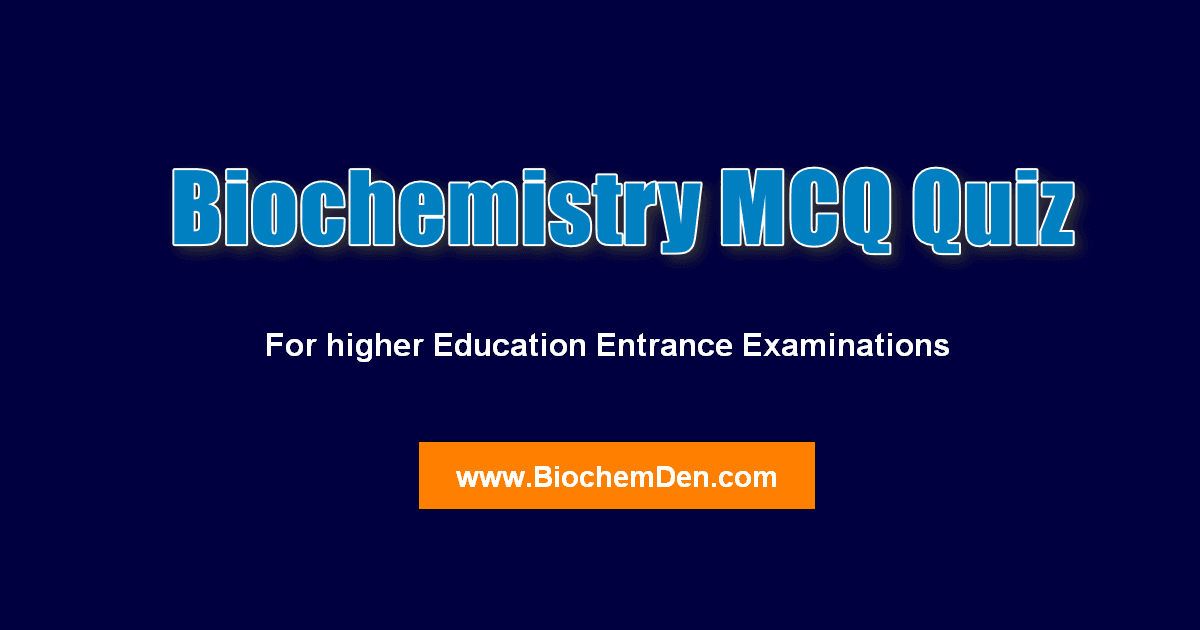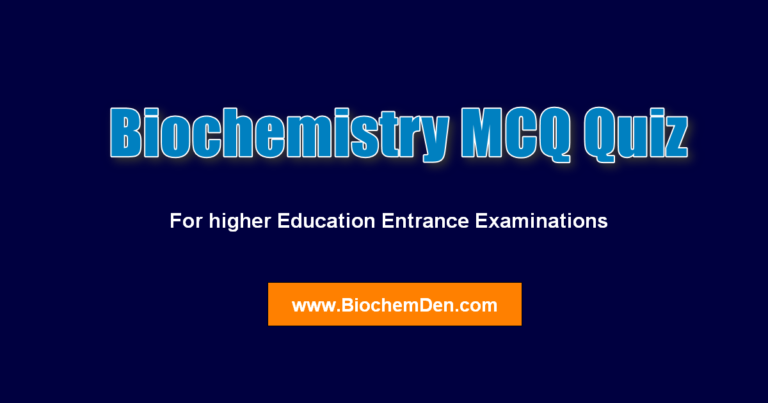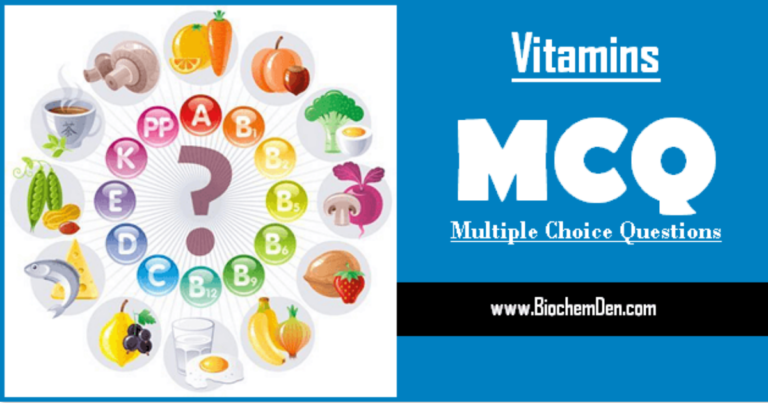
The Biochemistry MCQ (Multiple Choice Questions) contains 20 to 25 questions. Both questions and answers arranged randomly.
Biochemistry MCQ Pre Examination Part 2
1. Which combination of cofactors is involved in the conversion of pyruvate to acetyl-CoA?
A. biotin, NAD+, and FAD
B. pyridoxal phosphate, FAD, and lipoic acid
C. TPP, lipoic acid, and NAD+
D. biotin, FAD, and TPP
E. NAD+, biotin, and TPP
2. The protein that binds and directly reduces the terminal electron acceptor in mitochondrial electron transport is a. cytochrome oxidase.
A. coenzyme QH2
B. cytochrome bc1.
C. cytochrome oxidase
D. NADH: Q reductase.
E. succinate dehydrogenase.
3. In the digestive tract, disaccharides such as sucrose are hydrolyzed to monosaccharides mainly by enzymes located in the
A. gastric secretions.
B. lumen of the large intestine
C. saliva.
D. brush border of the small intestine
E. lumen of the small intestine.
4. Which enzyme is activated by direct binding of cAMP to a regulatory subunit?
A. Adenylate cyclase
B. Phosphorylase
C. Phosphorylase kinase
D. Protein kinase A
E. Protein phosphatase
5. The steps of glycolysis between glyceraldehyde 3-phosphate and 3-phosphoglycerate involve all of the following EXCEPT
A. reduction of NAD+ to NADH.
B. oxidation of NADH to NAD+
C. ATP synthesis
D. formation of 1,3 bisphosphoglycerate.
E. utilization of Pi.
6. Several hours after a meal, when blood glucose levels are approximately 6 mM, the glucokinase activity of the liver is approximately equal to the activity of
A. glucose phosphate isomerase.
B. glycogen glucose 6-phosphate dehydrogenase. synthetase.
C. Phosphofructokinase-1.
D. glucose 6-phosphate dehydrogenase.
E. glucose 6-phosphatase
7. A 23-year-old man is unable to exercise vigorously without developing muscle cramps. Studies of his exercising forearm reveal that during maximal work, he does not produce lactate. This individual most likely has a deficiency of
A. glycogen phosphorylase
B. PEP carboxykinase.
C. glycogen debranching enzyme
D. pyruvate dehydrogenase.
E. fructose 1,6 bisphosphatase.
8. In the elongation of glycogen, activated glucosyl units are attached to which hydroxyl of the terminal residue of the growing chain?
A. C-2
B. C-6
C. C-4
D. C-1
E. C-3
9. The conversion of 1 mol of pyruvate to 3 mol of CO2 via pyruvate dehydrogenase and the citric acid cycle yields ___mol of NADH, ____mol of FADH2, and ___mol of ATP (or GTP).
A. 4; 2; 1
B. 2; 2; 2
C. 4; 1; 1
D. 3; 2; 0
E. 3; 1; 1
10. Intermediates of the citric acid cycle are replenished by a reaction converting pyruvate to
A. oxaloacetate
B. succinyl-CoA
C. alpha-ketoglutarate
D. acetyl-CoA
E. citrate
11. In most tissues, an increase in the following ratio directly causes an increase in TCA cycle activity:
A. NAD+/NADH
B. NADH/NAD+
C. ADP/ATP
D. ATP/ADP
E. GTP/GDP
12. All of the following use coenzyme Q as either substrate or product EXCEPT
A. Complex III
B. Complex I
C. Complex II
D. Complex IV
13. All of the following compounds can serve as the starting material for the synthesis of glucose via gluconeogenesis EXCEPT
A. aspartic acid.
B. glycerol
C. oleic acid
D. alanine.
E. pyruvate.
14. Substrates for glycogen synthase are
A. UDP-glucose and the C-6 hydroxyl of primer.
B. UDP-glucose and the C-1 hydroxyl of primer
C. Glucose-1-phosphate and the C-4 hydroxyl of primer
D. glucose 1-phosphate and the C-1 hydroxyl of primer.
E. glucose 1-phosphate and the C-4 hydroxyl of primer.
15. A pathway/step of carbohydrate metabolism that is stimulated by insulin in muscle, but not in the liver:
A. Gluconeogenesis
B. Glycogen synthesis
C. Glucose transport
D. Glycogenolysis
E. Glycolysis
16. All of the following are products of the oxidative branch of the hexose monophosphate pathway EXCEPT
A. ribulose 5-phosphate.
B. NADH
C. NADPH.
D. CO2.
17. An enzymatic reaction that is most similar to the conversion of pyruvate to acetyl CoA is catalyzed by
A. citrate synthase.
B. succinate dehydrogenase.
C. isocitrate dehydrogenase.
D. alpha-ketoglutarate dehydrogenase
E. succinyl-CoA synthetase.
18. In the breakdown of muscle glycogen, the predominant product is
A. Glucose
B. Glucose 1-phosphate
C. Maltotriose
D. Maltose
E. UDP-glucose
19. The most important allosteric inhibitor of glycolysis in resting muscle is
A. AMP.
B. H+.
C. ATP
D. Fructose 2,6 bisphosphate.
E. cAMP.
20. When a muscle contracts aerobically, less lactic acid is formed than when it contracts anaerobically because under aerobic conditions
A. muscles cannot convert glucose 6-phosphate to pyruvate
B. most of the pyruvate generated is oxidized
C. the major source of energy is the pentose pathway
D. the lactic acid generated is rapidly converted back to glucose
E. the major source of energy is creatine phosphate
21. Which enzyme is used in gluconeogenesis but not glycolysis?
A. Aldolase
B. Phosphoglucoisomerase
C. Lactate dehydrogenase
D. Glucose 6-phosphatase
E. 3-Phosphoglycerate kinase
22. The conversion of 1 mol of glucose 1-phosphate to 2 mol of pyruvate by the glycolytic pathway results in a net formation of
A. 1 mol of NADH and 2 mol of ATP
B. 2 mol of NADH and 3 mol of ATP
C. 1 mol of NAD+ and 2 mol of ATP
D. 2 mol of NADH and 2 mol of ATP
E. 2 mol of NAD+ and 3 mol of ATP
Discover more from Biochemistry Den
Subscribe to get the latest posts sent to your email.


